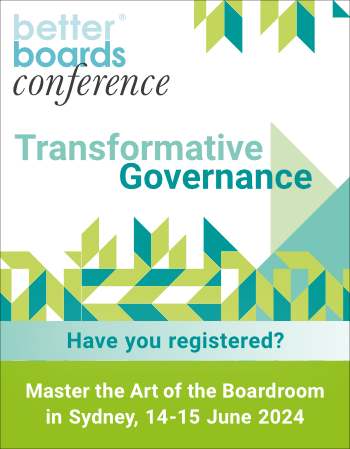board-recruitment
Why Am I on this Board? One Question, Three Ways
Published: February 13, 2017
Read Time: 5 minutes

Asking Board members to answer one simple question in three slightly different ways can unearth the reasons they’ve lost their passion. Their answers can also provide vital clues about how to reignite the flame.
You’re ploughing your way through another tedious non-profit board meeting and it hits you: What am I doing here? Why aren’t I spending my Saturday relaxing? Where’s my passion gone? Am I making a difference? Why am I so bored?
As a chairperson or CEO, you will have detected the board’s and your own disengagement in its earliest stages. You know a ‘bored board’ is a danger – but what can you do? The pressure’s on. These days you have to compete in a dynamic, customer-driven market and lacklustre performance just won’t cut it. Your board needs to be galvanised to provide leadership and strategic guidance, especially if you want to generate innovative, collaborative and exciting solutions for social change.
The growing malaise in boardrooms across the country prompts the inevitable (and ubiquitous) question at conferences such as this one: How do I engage my board members?
But asking the prior question is fundamental: Why have your board members switched off? Why have they lost their internal flame?
With the overwhelming focus now on ‘good governance’, I believe we often fail to harness the passion and power that lies behind a board member’s original motivation for signing up.
Boards are bored, and boring. What can be done?
According to Daniel Pink, in his book Drive: The Surprising Truth about What Motivates Us, people do not consistently lift their game in response to reward and punishment. In other words, board members won’t best be engaged through the use of a ‘carrot and stick’.
Pink offers an alternative framework based on intrinsic motivation – the joy of the task itself.
Let’s face it, though, the work of a board can be dull, time-consuming and difficult. When you only give your board compliance-driven, bureaucratic work to do, you risk losing the passion that convinced your members to join the board in the first place. People will stay on the board out of duty or habit – a ready formula for disengagement and poor performance. Transparency, professionalism and compliance are all important but harnessing personal drive is also critical. But how?
Working with Board members to rediscover their drive, and to learn how to nurture it, doesn’t have to be difficult or time-consuming. Give the following question, asked three ways, to individuals to use as a guide for self-reflection. You can also use it during board evaluations, board induction, board development planning, in camera board sessions or in one-on-one meetings with the chairperson.
1. Why am I on this board?
What spurred you to put yourself forward as a candidate or to agree to be nominated? What made you accept the role? Your answer could well be, ‘I wanted to give something back to the community’, but you will need to dig deeper to find what drives you. After all, there are other ways to give back to the community, like volunteering for more ‘frontline’ roles or donating money or pro bono professional services. Why did you decide on board membership? What did you hope or expect to gain from the experience? Did you want to: Make stronger connections in the community or sector? Use your skills in a different context? Develop particular skills or knowledge? Or demonstrate your personal passion for the cause your organisation serves?
Answering these questions will help you to identify where your current experience is not providing what you’d hoped for. Ask yourself what you or the board could change to increase your satisfaction and motivation.
2. Why am I on this board?
Why you? What is your unique value to the board’s work? If you were actively recruited to be on the board, what was the reason you were targeted? If you were elected, why were you chosen ahead of the other candidates? If you were the only person nominated, why did they choose you instead of nobody at all? Regardless of how you became a board member, you should be able to identify at least one thing that you, and only you, contribute to the board and the organisation. Answers could be that you have specific skills, character traits, connections or experience. Pin your answer down. If it still eludes you, ask yourself, ‘If I left this board, what would they lose?
Once you know what you offer the board, you should ask yourself, ‘How am I contributing? How could I contribute more in future or in a more effective way?
3. Why am I on this board?
Why this board and not the board of another organisation? For long-serving board members, it might be better for you to ask, ‘Why am I still on this board?’ You may have been invited to join the board by someone you liked and respected. You may have taken up the first board opportunity offered to you. Or you may have become a board member because of your long-standing connection with the organisation in other roles.
Dig deep and don’t settle for easy answers – particularly if your motivation is dwindling and your happiness waning. If answers don’t come to you, try asking yourself, ‘What would have to change for me to be happy with this board?’
To sum up
The self-reflection involved in answering this one question three ways may well be enough to re-energise your flagging board members and reignite their passion. Their answers should also generate good ideas for change.
An energetic, engaged and passionate board has the potential to transform an organisation in positive and exciting ways. Just one little question, asked three ways – I encourage you to give it a try.
This article was first published in the Better Boards Conference Magazine 2015.
Share this Article
Recommended Reading
Recommended Viewing
Author
-
Governance and Strategy Consultant
- About
-
Michelle has worked in corporate, government and non-profit organisations in Australia, Mexico, the United States and Thailand. She began as a trouble-shooter in finance and administration and moved on to strategic planning and relationship management. In 2009 Michelle completed an 18-month assignment as a volunteer management advisor for an indigenous NGO in the Solomon Islands. She returned to Australia with a strong commitment to helping non-profit organisations.
Found this article useful or informative?
Join 5,000+ not-for-profit & for-purpose directors receiving the latest insights on governance and leadership.
Receive a free e-book on improving your board decisions when you subscribe.
Unsubscribe anytime. We care about your privacy - read our Privacy Policy .










